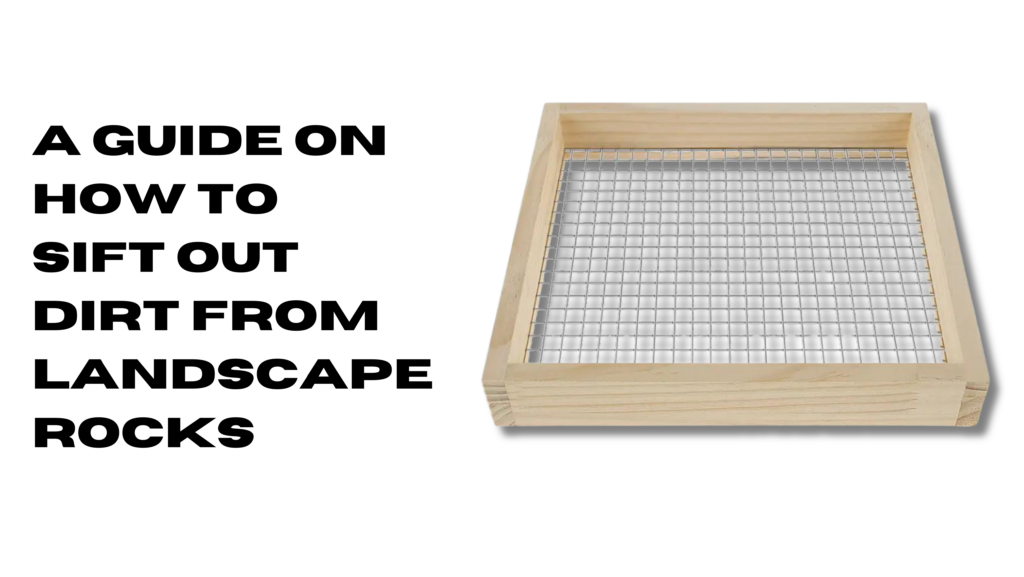Table of Contents
Maintaining a pristine landscape involves regular upkeep, and one common challenge is keeping landscape rocks clean and free from dirt and debris. Whether you’re dealing with gravel pathways, decorative rock gardens, or rock mulch beds, the accumulation of dirt over time can detract from the aesthetic appeal of your outdoor space. With the right tools and techniques, sifting out dirt from landscape rocks can be a manageable task. In this guide, we will walk you through the step-by-step process of efficiently cleaning your landscape rocks to restore their natural beauty.
1) Gather Your Tools
Before you begin the process, gather these necessary tools and materials. Which typically includes:
- A wheelbarrow or large container for collecting debris
- A sturdy garden hose with a nozzle attachment
- A stiff-bristled brush or broom
- A shovel or rake for gathering rocks
- A sifting screen or mesh

2) Remove Large Debris
Start by manually removing debris such as leaves, branches, and any other visible objects from the surface of the landscape rocks. This also includes the removal of weeds. Use a rake or shovel to gather these items into your wheelbarrow or container. This initial step is crucial as it not only clears the rocks of large debris but also creates a cleaner surface for the subsequent cleaning process. Removing these larger items also prevents them from clogging up the sifting screen later on, ensuring a smoother and more efficient cleaning experience. Additionally, by eliminating bulky debris first, you’ll have better access to the rocks for thorough cleaning, resulting in a more polished and visually appealing landscape. Sometimes you may need to remove the rock altogether so that you can install mulch instead. That’s why we wrote this blog titled 3 Reasons to Remove Rock and Install Mulch.
3) Rinse the Rocks
Use the garden hose with a nozzle attachment to thoroughly rinse the landscape rocks. Adjust the nozzle to a strong spray setting to loosen and remove surface dirt, focusing on crevices and edges. Pay close attention to areas where dirt tends to accumulate, such as between rocks or in tight spaces. The high-pressure spray from the nozzle helps dislodge stubborn dirt and grime, ensuring a more thorough cleaning. Targeting crevices and edges is important as these areas often trap debris and are harder to reach with manual cleaning methods alone. By giving special attention to these areas during the rinsing process, you’ll achieve cleaner and more pristine landscape rocks overall.
4) Scrub the Rocks
After rinsing, use a stiff-bristled brush or broom to gently scrub the rocks. This step is essential for dislodging stubborn dirt and stains particularly in areas with moss or algae buildup. The stiff bristles of the brush or broom provide additional scrubbing power, allowing you to effectively remove dirt that may not have been fully dislodged during the rinsing process. Focus on areas where moss or algae are present, as these can be challenging to clean and may require extra attention. By scrubbing the rocks, you’ll ensure a more thorough cleaning and restore the natural beauty of the landscape rocks, making them look fresh and revitalized.
5) Sifting Process
For a more thorough cleaning, use a sifting screen or mesh. Place the screen over a clean container and pour a small amount of rocks onto it. This step is particularly effective for removing fine dirt particles and smaller debris that may have been missed during the initial rinsing and scrubbing process. By using a sifting screen, you can achieve a higher level of cleanliness and ensure that your landscape rocks are free from even the tiniest particles of dirt. Shake the screen gently to allow dirt and smaller debris to fall through, leaving clean rocks on the screen. You may need to tap or lightly agitate the screen to encourage the dirt to separate from the rocks completely. Take your time with this process to ensure thorough cleaning and avoid any remaining dirt or debris on the rocks.
Repeat the sifting process with the remaining rocks until all have been sifted. This step-by-step approach ensures that every rock undergoes the thorough cleaning process, resulting in a uniform and pristine appearance for your landscape rocks. Using a sifting screen saves time and effort compared to manually inspecting each rock, making it a practical and efficient method for achieving clean and beautiful landscape features. We have attached a “how to” video on how to create a sifter easy to use at home!
6) Final Rinse and Inspection
Give the rocks a final rinse with the garden hose to remove any remaining residue. This final rinse is crucial in ensuring that all dirt, debris, and cleaning agents are completely washed away, leaving the rocks in their cleanest state. Adjust the nozzle to a gentle spray setting for this step to avoid displacing the rocks or creating unnecessary splashing. As you rinse the rocks, take the time to inspect them closely for any missed spots or areas that may require additionally cleaning. Use a flashlight or work during daylight to help you spot any overlooked areas effectively. If you notice any stains or persistent dirt buildup during the inspection, go back and give those specific areas extra attention. You can use a brush or scrubbing tool targeted for tough stains to ensure great cleaning. Taking the time to inspect and address any missed spots ensures that your landscape rocks will look immaculate and well-maintained once they’re dry and back in place. After completing the final rinse and inspection, allow the rocks to air dry completely before returning them to their designated areas in your garden or outdoor space. This step prevents water stains and ensure that the rocks are ready to enhance the aesthetic appeal of your landscape once again.
7) Allow to Dry
Let the landscape rocks air dry completely before returning them to their designated areas. This is not only important for aesthetic reasons but also for preventing potential issues such as mold or mildew growth. Allowing the rocks to dry thoroughly ensures that any remaining moisture is evaporated, reducing the risk of mold or mildew formation, especially in humid or damp environments. During the drying process, it’s essential to place the rocks in a well-ventilated area where air can circulate freely around them. Avoid stacking wet rocks on top of each other or placing them in areas with limited airflow, as this can prolong the drying time and create conditions conducive to mold or mildew development. Inspect the rocks once they are dry to ensure they are free from moisture and any signs of remaining dirt or debris. If needed, use a clean cloth or towel to pat dry any residual moisture before returning the rocks to their designated areas. By allowing the landscape rocks to air dry completely, you promote a healthier outdoor environment by preventing potential mold or mildew issues. This ensures that your landscaping efforts result in long-lasting beauty and functionality for your outdoor space.

By following these steps, you can effectively sift out dirt from your landscape rocks, keeping them clean and enhancing the appearance of your outdoor space. Clean landscape rocks not only contribute to the aesthetic appeal of your garden or outdoor area but also promote a healthier environment. Clean rocks create a more inviting and enjoyable outdoor space for relaxation, entertaining guests, or engaging in outdoor activities. Regular maintenance and cleaning of landscape rocks prolong the longevity of your landscape features, ensuring they remain beautiful and functional for years to come. Contact His Workmanship for support on how to sift out dirt from your landscape rocks.



